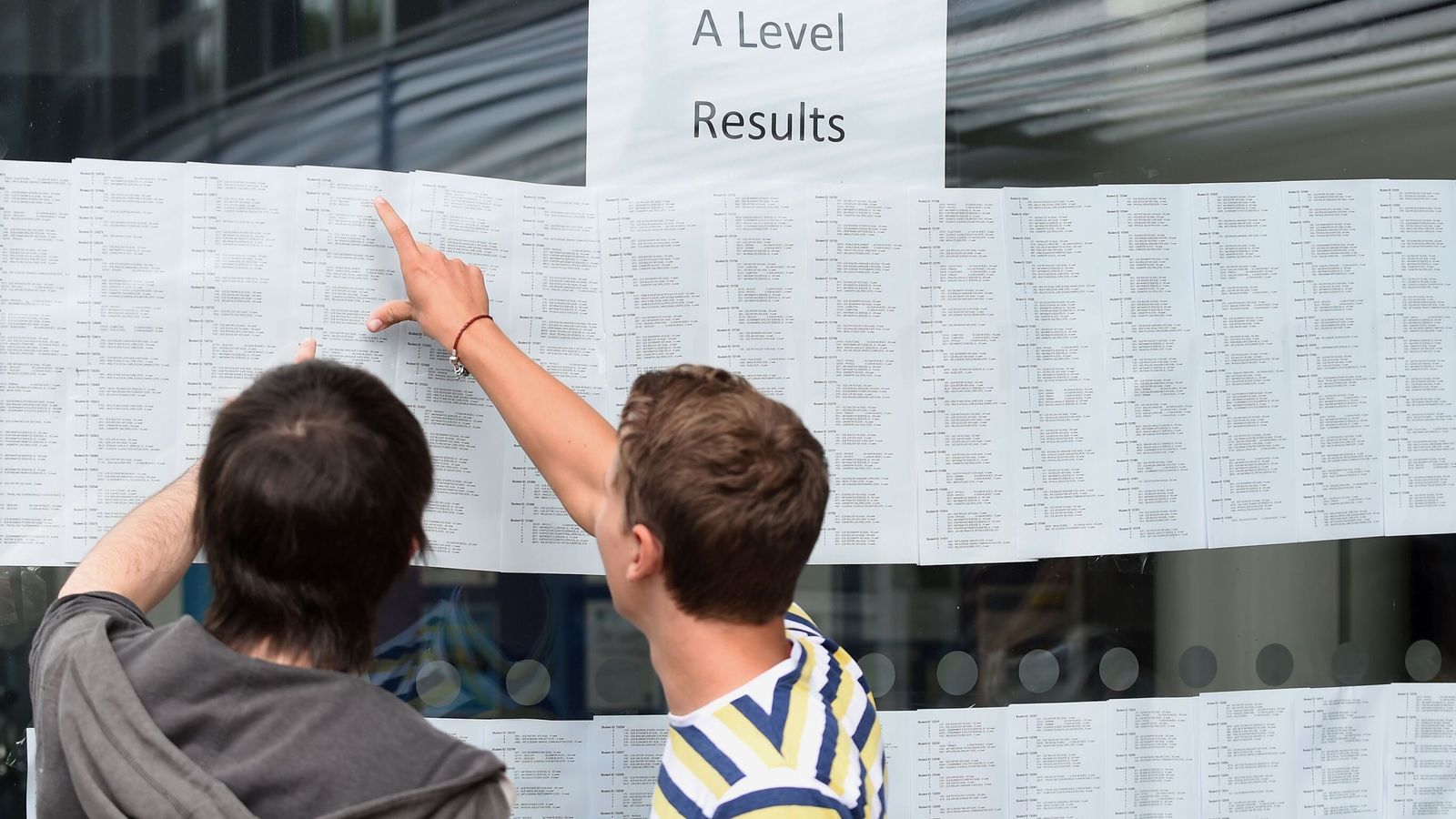The proportion of top A-level grades is down on last year but still remains above pre-pandemic levels.
A* and A grades were awarded to 27.2% of students, compared to 36.4% last year, 44.7% in 2021 and 38.5% in 2020.
But the number is up by 1.8% compared to pre-pandemic levels, when 25.4% of A-level entries were awarded A or A* grades.
Follow the latest A-level news live here
The overall pass rate – the proportion of entries graded A* to E – has fallen to 97.3% this year, which is lower than 2022 (98.4%) and the pre-pandemic year of 2019 (97.6%). In fact, the rate is at its lowest level since 2008 when it stood at 97.2%.
Pupils in England saw the biggest drop in top marks, with the share of exams graded A or above down by 9% compared to 2022.
Welsh students saw a 7% drop in top grades while Northern Ireland saw a decrease of 6%.
But compared to the last summer before the pandemic in 2019, the number of top grades awarded in England is up by 2%, in Wales by 7% and in Northern Ireland by 9%.
The figures, published by the Joint Council for Qualifications (JCQ), cover A-level entries from students in England, Wales and Northern Ireland.
In England, exams regulator Ofqual had said this year’s A-level results would be lower than last year following efforts to return to pre-pandemic grading.
It comes after COVID-19 led to an increase in top grades in 2020 and 2021, with results based on teacher assessments instead of exams.
In Wales and Northern Ireland, exam regulators have said they do not plan to return to pre-pandemic grading until 2024.
Many A-level students in Wales and Northern Ireland were given advance information about topics to expect in their exam papers this summer but students in England were not given the same support.
“The reality is that those systems are different anyway, they’re different awarding bodies,” Education Secretary Gillian Keegan told Sky News when asked if there were questions about fairness.
“University admissions officers know the difference in these systems so they’re quite sophisticated in understanding the difference between the English system and the Scottish system.”
There are still regional differences when it comes to the share of students achieving top grades.
Compared to pre-pandemic levels, the number of pupils receiving A-A* grades is still up by 3.1%. That compares to the North East, where 1% fewer pupils achieved top marks.
But overall, students in the South East achieved the greatest share of top marks, with more than 3 in 10 papers (30.3%) receiving A-A* grades. That compared to 22% in the North East, 22.3% in the East Midlands, 22.9% in the West Midlands, 24.1% in the North West and 26.6% in the East.
Boys scored more A* grades this year compared to girls, at 9.1% compared to 8.8%.
A total of 3,820 students in England alone scored three A* grades, according to separate figures from exams regulator Ofqual.
This is down from 8,570 last year, but up from 2,785 in 2019.
Maths still remains the most popular A-level subject, followed by Psychology, Biology, Chemistry, History, Sociology, Business Studies, Art and Design, Economics and Physics.
Computing saw the biggest increase in entries, up by 64% since 2019. Media and film studies, as well as political studies and economics, also saw increases in entries.
There is still a big difference in the type of subjects male and female students are choosing to take at A-level.
Of the 15 most popular subjects, 77% of those choosing to take physics are male compared to 78% of those studying English Literature being female.
UCAS also says fewer A-level pupils have gained a place at their first choice of university or college compared to last year.
It said 79% secured their first choice, compared to 81% in 2022, when exams were re-introduced and 74% in 2019, when grading arrangements were the same as this year.
A further 9% of students are in clearing, which compared to 12% in 2019 and 7% in 2022.
Elsewhere, 12% have been placed at their insurance choice, compared to 14% in 2019 and 11% in 2022.
More than twice the number of students from advantaged backgrounds (76,780) were accepted compared to those from disadvantaged backgrounds (25,760).
UCAS Chief Executive Clare Merchant said: “Today’s data shows that challenges in widening participation to the most disadvantaged students still persist.
“This demonstrates that we all need to continue the efforts to ensure the most disadvantaged individuals in society are able to benefit from life-changing opportunities in higher education and training, particularly as the 18-year-old population grows”.
Overall, 414,940 applicants have gained a place at university or college, down from 425,830 last year but up on 408,960 in 2019.
Pupils in Scotland received their results last week and the Scottish Qualifications Authority figures showed that the Higher pass rate was down from last year but it remained above 2019 levels.

